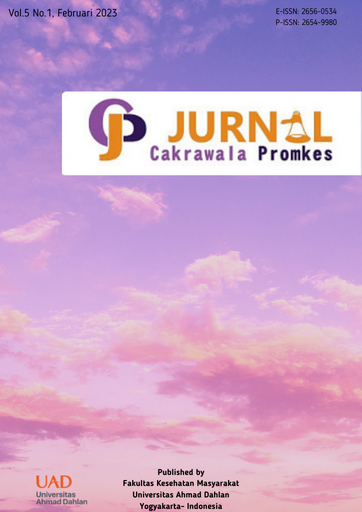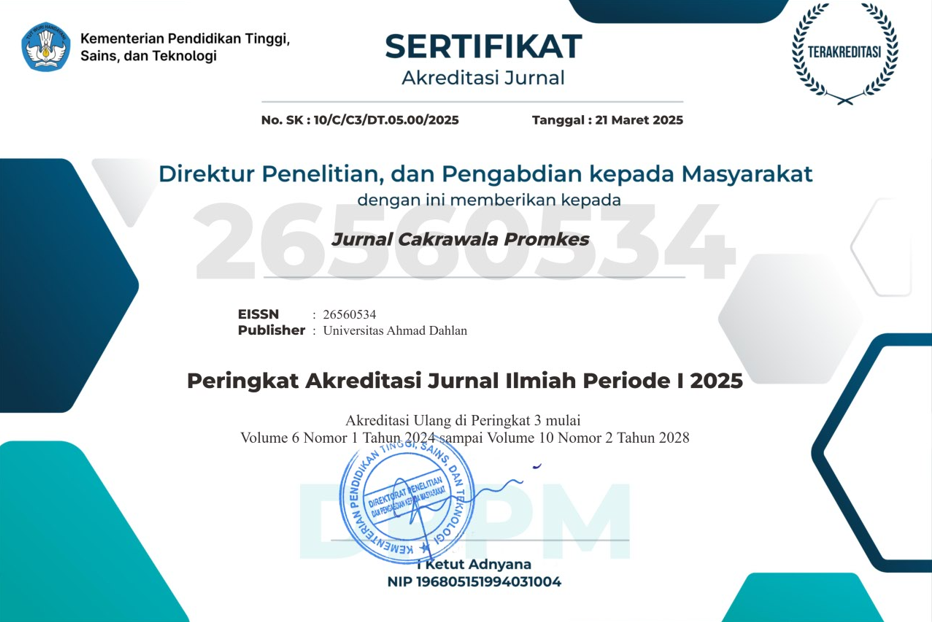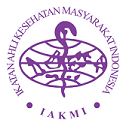Hubungan pengetahuan dan personal hygiene dengan kejadian pediculosis capitis pada anak SD Mutihan di Banguntapan, Bantul
DOI:
https://doi.org/10.12928/promkes.v5i1.6678Keywords:
Knowledge, Personal hygiene, Pediculus capitisAbstract
The prevalence of pediculosis capitis among Yogyakarta's rural elementary school students was 19.6%. The circumstance in urban area was slightly better with prevalence of 12.3% among similar group of students. The aim of this study was to seek the association of the knowledge and personal hygiene with the incidence of pediculosis capitis among students in SD Negeri Mutihan Yogyakarta. This study employed a cross-sectional design and nonprobability sampling to collect the research sample. A questionnaire was distributed to 111 students who agreed to participate in the study. Data was analysed with the Chi-Square Test and Relative Risk. Participants consisted of 65 boys (58.6%) and 46 girls (41.4%). The number of participants who had sufficient knowledge on pediculosis capitis, had good personal hygiene, and suffered pediculosis capitis were 58.6%, 63%, and 36.9%, respectively. Poor knowledge increased the risk of developing pediculosis capitis by 5.9 times. In contrary, poor personal hygiene can reduced its risk. Knowledge and personally hygiene are important factors to determine the incidence of Pediculosis Capitis.
References
Yousefi, S, Shamsipoor F AY. Epidemiological Study of Head Louse (Pediculus Humanus Capitis) Infestation Among Primary School Students in Rural Areas of Sirjan County, South of Iran. Thrita J Med Sci. 2012;1(2):53–6.
Mohammadi-Azni S. Prevalence of head lice at the primary schools in Damghan. Zahedan. J Res Med Sci 16, 47–49. 2014;16:47–9.
Nategh, A., Eslam, M.A., Davoud, A., Roghayeh, S., Akbar, G., Hassan, B., Mehdi S, Primary. Prevalence of Head lice infestation (Pediculosis Capitis) among primary school students in the Meshkin Shahr of Ardabil Province. Am J Pediatr. 2018;4:94– 99.
Alberfkani, M., Mero, W.M.S. The incidence of Scabies and Head lice and their associated risk factors among displaced people in Cham Mishko Camp, Zakho City, Duhok Province. Iraq. . J Microbiol 69, 463–469. 2020;69:463–469.
P.M. Linardi, J.R. Botelho MM. Crendices e falsos conceitos que dificultam ações profiláticas contra o piolho e a pediculose capitis. J Pediatr. 1988;64(1):248–55.
A.M. Bailey PP. Persistent of head lice following multiple treatments: Evidence for insecticide resistance in Pediculus humanus capitis. Australas. J Dermatol. 2000;41(1):250–4.
C.N. Burkhart CGB. Fomite transmission in head lice. J Am Acad Dermatol. 2007;56(1):1044–7.
M. Shayeghi, A. Paksa, Y. Salim Abadi, A. Sanei Dehkoordi, A. Ahmadi, M. Eshaghi SB. Epidemiology of head lice infestation in primary school pupils, in Khajeh City, East Azerbaijan Province Iran. J ArthropodBorne Dis. 2010;4(1):42–6.
R. Speare PGB. Head lice in pupils of a primary school in Australia and implications for control Int. J Dermatol. 1999;38(1):285–90.
M. Motovali-Emami, M.R. Aflatoonian, A. Fekri MY. Epidemiological aspects of pediculosis capitis and treatment evaluation in primary schoolchildren in Iran. PJBS. 2008;11(1):260–4.
S. Mahmud, G. Pappas WCH. Prevalence of head lice and hygiene practices among women over twelve years of age in Sindh, Balochistan, and North West Frontier Province: National Health Survey of Pakistan, 1990–1994. Parasit Vectors. 2011;4(1):1–10.
Combescot-Lang, C., Vander Stichele, R.H., Toubate, B., Veirron, E., Mumcuoglu KY. Ex vivo effectiveness of French over-the-counter products against head lice (Pediculus humanus capitis De Geer, 1778). Parasitol Res. 2015;114,:1779–1792.
AL-Shawa RM. Pediculus capitis, infestation according to sex and social factors in Gaza Governorate. IUJ. 2008;16:75–83.
Moradiasl, E., Rassi, Y., Hanafi-Bojd, A.A., Vatandoost, H., Saghafipour, A., Adham D, Aabasgolizadeh, N., Oskouei, A.O., Sadeghi H. The Relationship between Climatic Factors and the Prevalence of Visceral Leishmaniasis in North West of Iran. Int J Pediatr. 2018;6:7169–7178.
Munusamy, H., Murhandarwati, E.E & Umniyati S (n. d. . The Relationship Between The Prevalence of Head Lice Infestation with Hygiene and Knowledge Among The Rural School Children In Yogyakarta. Trop Med J. 2011;Vol. 01(2):102–9.
Anastasia Joyce Lim Yit Zhen , E. Elsa Herdiana Murhandarwati SRU. Head Lice Infestation and Its Relationship with Hygiene and Knowledge among Urban School Children in Yogyakarta. Trop Med J. 2011;01(1):35–41.
Sugiono. Metode Penelitian Kuantitatif, Kualitatif, dan R&D. Bandung: Alfa Beta CV; 2017.
AL Bashtawy, M., Hasna, F EMHJ 18 43-84. Pediculosis capitis among primary school children in Mafraq Governorate, Jordan. EMHJ 18, 43-84. 2012;18:43–84.
Riyanto A. Aplikasi Metodologi Penelitian Kesehatan. Yogyakarta: Nuha Medika; 2011.
Setyoasih, Atik dan Suryani D. Hubungan antara Pengetahuan, Personal Hygiene, dan Infestasi Pediculus humanus var. capitis pada Santriwati Muhammadiyah Boarding School Prambanan Sleman Yogyakarta. J Kedokt dan Kesehat. 2016;12(2):190–201.
Anggraini A, Anum Q, Masri M. Hubungan Tingkat Pengetahuan dan Personal Hygiene terhadap Kejadian Pedikulosis Kapitis pada Anak Asuh di Panti Asuhan Liga Dakwah Sumatera Barat. J Kesehat Andalas. 2018;7(1):131.
Notoatmodjo S. Ilmu perilaku kesehatan. Jakarta: PT Rineka Cipta;
Özdemir A., Ünal E. ÇL. The Prevalence of Pediculus Capitis and Personal Hygiene Status in Two Vocational High Schools. Int J Caring Sci . 2019;12(2):658–65.
Hanadi B.Baghdad, Eltigani O.M.Omer DMMR-G. Prevalence of head lice (Pediculus humanus capitis) infestation among schools workers in the Eastern Region, Saudi Arabia. Saudi J Biol Sci. 2021;28(10):5662–6.
Downloads
Published
Issue
Section
License
Copyright (c) 2022 Hariza Adnani

This work is licensed under a Creative Commons Attribution-ShareAlike 4.0 International License.
Authors who publish with JCP: Jurnal Cakrawala Promkes agree to the following terms:
- Authors retain copyright and grant the journal the right of first publication with the work simultaneously licensed under a Creative Commons Attribution License (CC BY-SA 4.0) that allows others to share the work with an acknowledgement of the work's authorship and initial publication in this journal.
- Authors are able to enter into separate, additional contractual arrangements for the non-exclusive distribution of the journal's published version of the work (e.g., post it to an institutional repository or publish it in a book), with an acknowledgement of its initial publication in this journal.
- Authors are permitted and encouraged to post their work online (e.g., in institutional repositories or on their website) prior to and during the submission process, as it can lead to productive exchanges, as well as earlier and greater citation of published work.

This work is licensed under a Creative Commons Attribution-ShareAlike 4.0 International License












